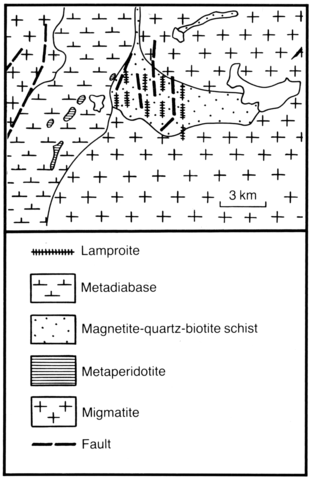stripes
Dykes of micaceous picrites are confined to north-south-trending fault zones in the Archaean Kontokskaya and Gimolskaya series. The dykes are uniform with thicknesses varying from 0.5 to 3.5 m. The rocks are characterised by porphyritic textures with olivine phenocrysts constituting 10-20%; they are generally replaced by serpentine and less often by talc and carbonate. The groundmass is composed of phlogopite (20-40%), serpentine after olivine (2-35%) and diopside replaced by actinolite (5-15%), with subordinate amounts of talc, calcite and rarely hypersthene. Less frequently the groundmass is made up of pseudoleucite (up to 30%), phlogopite (25%), olivine (15%) kaersutitic amphibole (3-5%) and calcite. The accessory minerals are apatite, magnetite, pyrite, baryte, chrome picotite, titanite, leucoxene and anatase, with more rarely columbite and rutile. In the Russian literature the rock chemistry and mineral compositions are taken to indicate that these rocks are lamproites.
GORKOVETZ, B.Ya., RAYEVSKAYA, M.B, BELOUSOV, E. and IRINA, K.A.. 1981. Geology and metallogeny of the Kostomuksha ore deposit region. 107-9. Petrozavodsk, Karelia. 143 pp.
ORLOVA, M.P. and SHADENKOV, E.M. 1992. Lamproites of Kostomuksha. Zapiski Vsesoyuznogo Mineralogicheskogo Obshchestva, 6: 33-43 .

